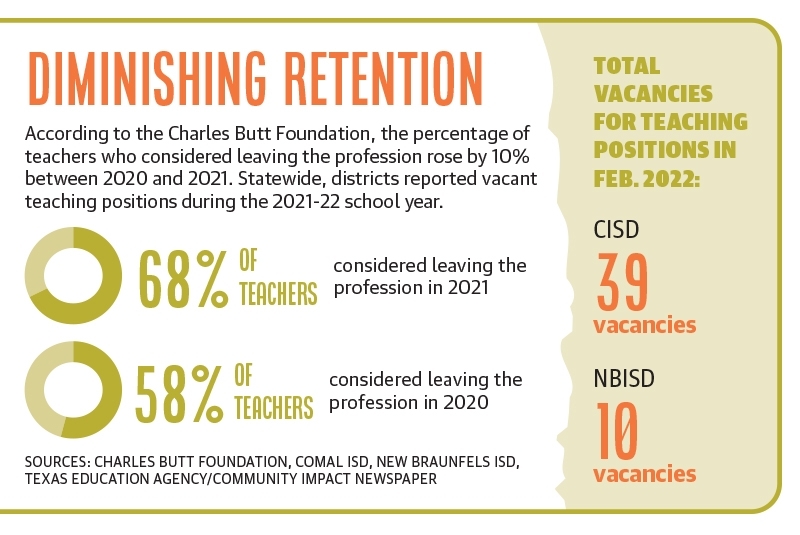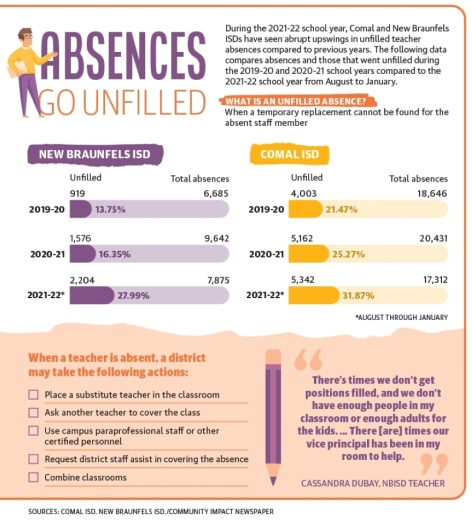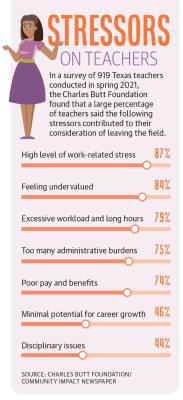For Cassandra Dubay, a life skills teacher at Klein Road Elementary School, recent staff shortages have made it difficult to meet the needs of her students.
The life skills program is tied to the New Braunfels ISD special education program and teaches functional communication and academic skills. Because her students require additional support in the classroom, Dubay said the challenge to find consistent staff has been taxing on her and her students.
“We’re not fully staffed in my classroom, so literally every day it’s almost a new substitute. [The district] tried to get the same subs to come back, but depending on their schedule, subs don’t work every day,” she said. “It’s really hard on my students when they have yet someone else new in the room, someone who doesn’t know our routine.”
As teacher absences have risen in Comal and New Braunfels ISDs and the districts struggle to fill openings, state data indicates the current shortages are part of historic staffing issues impacting districts throughout the country.
As spikes in COVID-19 cases throughout Central Texas saw a rise in absences among staff and students during the first six months of the school year, districts needed to combine classes, suspend some bus routes and host frequent hiring events in an effort to fill positions.
Dubay has been a life skills educator for more than five years and joined NBISD for the 2021-22 school year. While finding substitute teachers and paraprofessionals has been a challenge for years, she said this year has presented more significant hurdles for staffing.
“We had COVID[-19] going through us, and we were so short for acouple weeks and it was so difficult on everybody,” Dubay said. “There’s times we don’t get staff filled and we don’t have enough people in my classroom or enough adults for the kids. ... There [are] times our vice principal has been in my room to try to help.”
Spiking unfilled absences
Andria Trumble, whose children are enrolled at NBISD, said she was not fully aware of the extent of local substitute shortages until her daughter shared that she had been moved to the school gym several times where classes were combined if not enough staff or substitutes were available.
“This has happened quite a few times when a teacher has been out,” Trumble said. “Probably more than 15 occasions just this school year where she’s ended up in the gym for one or more class periods.”
Recent data from CISD and NBISD shows unfilled absences increased from 24% in CISD and 11% in NBISD in January 2020 to 34% in both districts in January 2022.
From August 2021 to January 2022, NBISD recorded 7,785 absences among staff who require a substitute, such as teachers and other educational personnel, compared to just 5,099 absences from August 2020-January 2021.
In CISD, officials reported a total of 17,312 absences requiring a fill during the first six months of the school year, compared to 10,750 during the same period the previous school year.
When a substitute or other staff member cannot be found to cover an absence, the position goes unfilled, driving down the fill rate, or percentage of absences requiring a fill that were staffed.
“We did have a couple of weeks in January where our curriculum department stepped in and helped campuses who were looking at, you know, the 70% or 60% fill rate,” said Bobbi Supak, assistant superintendent of human resources at CISD.
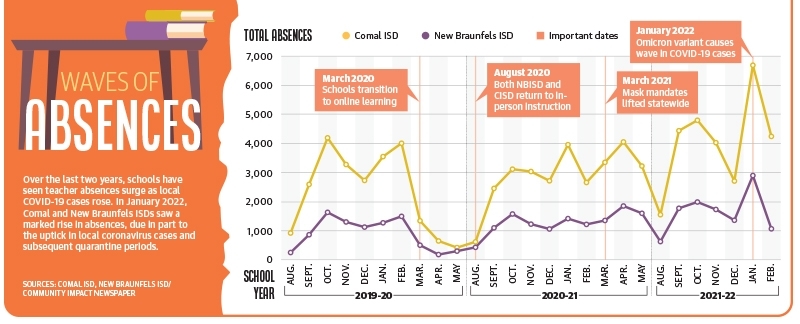
The district is currently onboarding between 15 and 20 new substitute teachers each week, she said, and officials have been working to shorten the process to become a substitute teacher.
Additionally, CISD created “super sub” positions during the 2020-21 school year to provide more consistent support on campuses.
“Those are substitutes that are committed to a campus so a campus can have anywhere from two to four ‘super subs’ and that has really helped fill in those vacancies,” Supak said.
In the event that a substitute cannot be found, some students have joined other classrooms or other teachers will take on classes during their planning period, Dubay said.
When Trumble’s son’s German teacher was out for several weeks at the beginning of the year, a French teacher stepped in to instruct the class, she said.
So far, neither district has had to cancel classes altogether, but shortages in other areas have caused disruptions to other school services.
Both districts have experienced bus driver shortages and CISD reduced the number of routes operating within the district due to lack of available drivers. NBISD has not reported route cancellations but officials shared that the district had 25 bus driver vacancies in early February.
Though Trumble understands that shortages are largely outside the district’s control, she said that lack of campus-specific communication regarding the issue is concerning.
“I was a little surprised that they haven't said anything to us about our schools on an individual level,” she said. “I don't want my kids to have some huge deficit somewhere that you won't know about until you know, we’re too far down the line to do anything about it.”
Human resources personnel for New Braunfels ISD declined to comment for this story.
Shrinking retention rates
In addition to short-term staffing issues, districts across the state have been hemorrhaging teachers and struggling to replace them as part of a long-term, national pattern.
Public school advocacy group Raise Your Hand Texas recently released its 2021 Texas Teacher Workforce Report, which showed that teachers are least likely to be retained from year one of teaching to year two.
The study followed a cohort of teachers who began their career in the 2010-11 school year. Between the first and second years, 12.5% of teachers did not return to the profession and by the 2019-20 school year, 50.2% of that original cohort had left.
“The trends show that we were having a difficult time attracting and retaining teachers even prior to COVID-19 especially in high need areas,” said Bob Popinski, senior director of policy for Raise Your Hand Texas. “If you look at the workforce as a whole, not just the teaching profession, but nursing and other professions, it's been a hard time attracting or retaining staff over the last couple years and it hasn't missed the teaching profession.”
In mid-February, NBISD had 10 teacher vacancies while CISD had 39 and current teachers had spent an average of 7 years or 5.3 years with their district, respectively.
While vacancies have been higher this school year compared to years before the COVID-19 pandemic, a recent survey conducted by the Charles Butt Foundation, a sister organization of Raise Your Hand Texas, found that 68% of Texas teachers surveyed considered leaving the profession in 2021, compared to 58% in 2020.
“There has been an increase in our attrition rate of people leaving the profession, especially leaving the profession within a couple of years of starting,” said Kate Fraser, a middle school teacher at CISDs Danville Middle School. “All of those teachers in the middle, that like eight to 15 years of experience, we've lost them and are losing them. We're losing them to other districts, we're losing them to other professions.”
High levels of work-related stress, feeling undervalued, long hours and low pay were several of the key reasons teachers listed as contributing to their consideration of leaving the profession, according to the Charles Butt Foundation survey.
As the nation grapples with the highest inflation rates seen since the 1980s, Popinski said teacher pay decreased by approximately $1,200 statewide between 2010 and 2020 when adjusted for inflation.
Average annual teacher pay in NBISD was $56,482 during the 2020-21 school year, while the average salary of a teacher in CISD was $55,233, according to data from the Texas Education Agency. The state average was $57,641 during the same year.
In November, voters passed a Voter-Approved Tax Ratification Election in CISD, which allowed the district to set a higher maintenance and operations tax rate than its current rate and to utilize funds generated by the rate for staff and teacher salaries.
The VATRE’s passage paved the way for teachers to receive a 3% pay increase each year and retroactively applied to the 2021-22 school year. Auxiliary personnel also received a $1.50 hourly pay increase as a result of the VATREs passage.
In February, the NBISD board of trustees approved a plan to pay all full-time employees $1,000 and all half or part-time employees $500 as a retention bonus. The payments were made out of available funds that had been budgeted for staff salaries that went unpaid due to staff shortages.
“We've had a lot of employees that are covering during conference periods while others are out sick. ... It's no secret that we are also short staffed,” said NBISD Superintendent Cade Smith during a Feb. 7 school board meeting. “If we're not hiring the staff then some of the funds that we have budgeted are not being utilized.”
Both districts also utilized available federal Elementary and Secondary School Emergency Relief grant funding to create additional support staff positions, though not all of those positions have been filled.
Despite these efforts, Fraser said many teachers are still considering leaving the profession because of the increasing number of administrative tasks and student performance expectations placed on them.
“Over the course of the 18 years that I've been in education we have steadily been asked to do more with less, and it's exhausting,” she said. “Some of these industries have realized that teachers are fast learners and incredibly hard workers and pretty loyal and devoted and are snapping teachers up and paying them two to three times what they were making in the classroom for shorter hours and less responsibility. So you know, who can blame someone for jumping at that?”
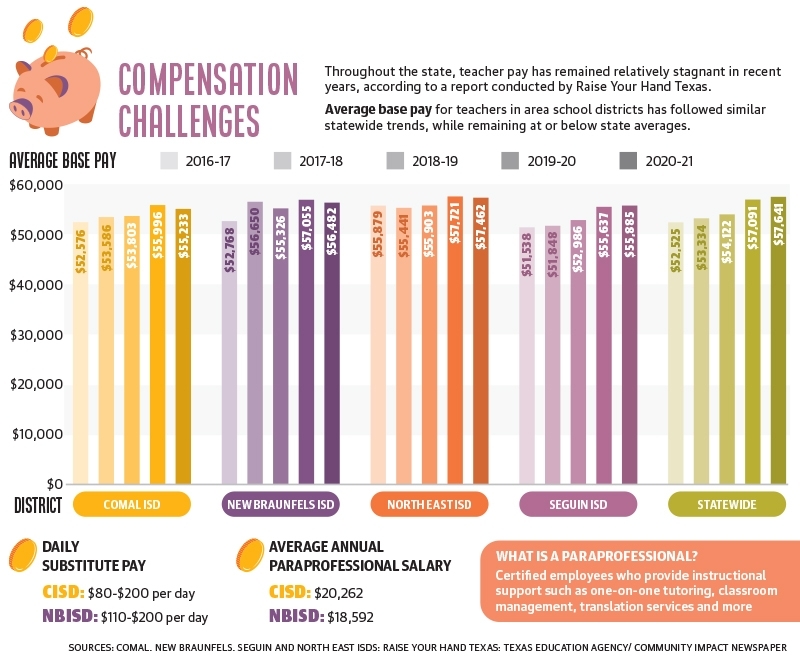
Combatting losses
Though district officials are unsure when the current surge in absences and staffing shortages will subside, administrators are continuing to work to fill open positions.
“We're really working hard on recruiting. We have our job fairs here that we do and we're also going out to several of the universities,” Supak said. “Talking to the universities, they don't have as many education majors as they once did.”
Bolstering teacher training programs and providing financial support for those considering entering the profession are key to addressing the dwindling number of aspiring educators, Popinski said.
Several scholarship programs offer students assistance to become teachers, Popinski said, but addressing financial security is not the only factor contributing to the decline in new teachers and retention.
“Compensation is a factor. But when you really dig into the research about why teachers leave the profession, it has a lot to do with one how prepared they feel to be successful on a day-to-day basis in their jobs, the working conditions, the school culture, how strong an environment they're working in,” said Lindsay Whorton, president of The Holdsworth Center.
The Holdsworth Center is a nonprofit organization that works to train leaders in the education profession, both at the campus and district level, to be able to provide resources teachers need and to better understand the needs of educators.
Whorton said the strength of a principal and school leadership team is critical to the success of teachers. When teachers feel supported by their administrators, they are more likely to stay and continue to grow in their career, she said.
For Fraser, if teachers were given more opportunities to participate in decision making and had a voice to express their students' needs, fewer teachers would leave the profession.
“I think districts have to be willing to engage with teachers and involve them in the decision making process for the district,” she said. “Almost every single educator I know came into education to work with children and to try and make a difference in our community. And if we feel like we are part of something that is truly having a positive impact on our community, our students, then we will be 110% committed to that.”
